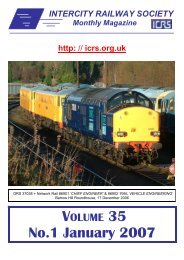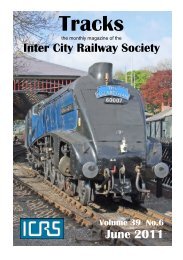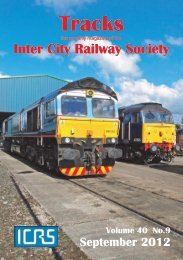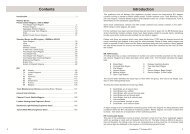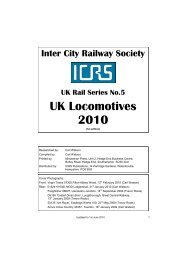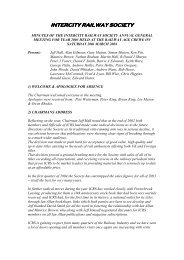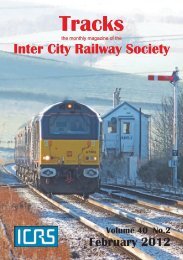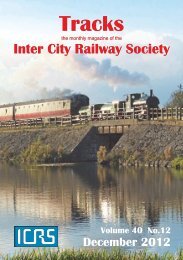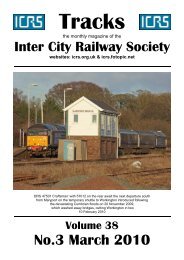September - Intercity Railway Society
September - Intercity Railway Society
September - Intercity Railway Society
You also want an ePaper? Increase the reach of your titles
YUMPU automatically turns print PDFs into web optimized ePapers that Google loves.
Freight Corner<br />
WAGON UPDATES by Scott Yeates (to UKRS No.3 UK Wagons 2011):<br />
To allow members to keep their copy as up to date as possible, it is intended to provide changes via<br />
this spot every month. It is known that various wagons reportedly withdrawn or missing from previous<br />
editions are still in service so if any member can provide information please let Scott know, contact<br />
details on page 2.<br />
Nothing to report.<br />
FREIGHT NEWS by Martin Hall<br />
Colas has begun a new freight service transporting coal from Wolsingham to Tata Steel Works and<br />
Ratcliffe Power Station. They have also purchased 66573-577 from Eversholt Leasing and<br />
renumbered them 66846-850.<br />
Devon & Cornwall <strong>Railway</strong> (DCR) has been given a freight licence and has been running trials with<br />
bogie scrap wagons from Derby to Immingham.<br />
Freightliner has also begun a new service of coal from Leith Docks to Longannet Power Station.<br />
It nice to see re-cycling with former Direct Rail Rover Bogie Cube wagons being converted by EG<br />
Steele of Hamilton into timber carriers for Colas Rail. The first one completed is 33.70.4739.074-1.<br />
WAGON REVIEW by Martin Hall<br />
Miscellaneous Private Owner Wagons:<br />
Privately owned (PO) wagons prior to World War II were principally 4 wh 5pl and 7pl open wooden<br />
mineral wagons owned by collieries for the vast movement of coal around Britain with a great variety<br />
of liveries and lettering. These were inherited by the big four after 1923 and many continued through<br />
to nationalisation with many others repainted into plain corporate liveries with GWR, LMS, LNER or<br />
SR lettering. But the ravages of hard work, abuse and little maintenance throughout WW2 meant most<br />
PO wagons were in poor condition when they were incorporated into the nationalised British <strong>Railway</strong>s<br />
in 1948. Many planks were replaced without the former lettering being renewed so creating a<br />
patchwork livery. Nationalisation all but ended the practise of separate companies running their own<br />
wagons on BR metals apart from a few specialised types like tanks. But as freight began to decline<br />
and speeds needed to increase in block trains to compete with road haulage, BR relaxed its attitude to<br />
private companies and in the 1970s a renewed program of private owner wagon construction began.<br />
Many private companies could now move their products, albeit with the help of BR who still ran the<br />
loco fleets. A different variety of liveries began to appear in the early days of private ownership and<br />
following the 1996 privatisation, several companies like DRS, Freightliner, Foster Yeoman and GB<br />
Railfreight either own or lease locomotives. Many PO wagons have survived into preservation and<br />
have been restored as in the case of the two 7pl wooden mineral wagons below, although as is<br />
common, both are of unknown provenance.<br />
9988 NRM, York, 2 May 2011 421 Midland Rly Butterley, 17 August 2010<br />
35



